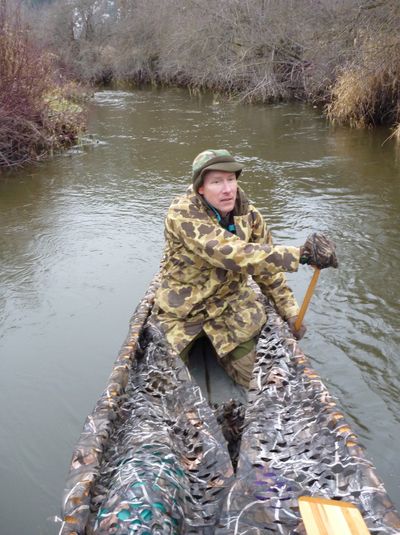Tips for safe canoe hunts

The canoe is a time tested, inexpensive and efficient way to hunt waterfowl on certain waters, ranging from the Clark Fork River in Montana and Idaho to the Winchester and Frenchman Hills wasteways in the Columbia Basin – and many of the navigable streams and sloughs in between.
Ducks often pile into small streams when cold-weather fronts move in. A canoe is a remarkably quiet and portable vessel a hunter can use to get to them, making it fairly easy to get around logjams and over fingers of land.
On a recent paddle trip for puddle ducks on an area stream, years of good and bad experiences flashed through my mind as we rounded bends and jump-shot mallards springing into flight from the shoreline brush.
While the stern paddler guides the canoe as silently as possible, the bowman loads his gun and readies to fire at ducks that can flush from any bend or brush on the shoreline.
Every bend in the river is a new hunt.
After every shooting opportunity, the hunters switch places.
I’ve learned many techniques and lessons from trial and error and observing the mishaps of others over 40 years of canoe hunting. I still make mistakes, such as chit-chatting too much with my partner and blowing the opportunity to shoot at ducks that often flush from where you least expect them to be hiding.
But on safety issues, there can be no compromise in a skinny boat on frigid waters.
John Roland, a waterfowl hunter and expert paddler with the Spokane Canoe and Kayak Club, helped me compile the following tips we gleaned from our recent successful duck hunt and years of other four-season experiences in canoes.
• Only one person should shoot at time. Canoes are notorious for capsizing when both hunters shoot to one side with no one to brace the boat with a paddle.
• Learn paddling skills in summer when the water is warm and you won’t succumb to hypothermia if you need practice in centering your weight.
• Pick your weather and plan ahead for windy conditions.
• Scout the water before the trip, not only to check for waterfowl, but also to make sure it is not beyond the skills you and your partner possess.
• Always wear a PFD. Lifejackets help keep a paddler warm during the fun of a hunt, and help save lives in a crisis. If you don’t have a camouflage model, don a camo windbreaker or rain jacket over top.
• Don’t wear anything that would prevent you from jumping in the water and swimming to shore.
• Don’t overload the canoe with decoys and gear or people too large for the boat. A dozen decoys are all you need for setting up along streams or small sloughs.
• Clip in dry bags with a change of clothing for each paddler, just in case.
• Kneeling enables paddlers to be more stable in a canoe, but it requires the seats be mounted in a manner to ensure enough clearance for your feet. Gripping rubber kneeling pads should be installed on the bottom of the boat for each paddler.
• A dog that isn’t thoroughly trained to sit calmly and remain still until commanded to retrieve is a liability in a canoe.
• Religiously unload your shotgun when switching bow-stern positions or laying the gun down for breaks or portages, such as around log jams.
Most of all, be ready for all kinds of experiences.
The stealth of a canoe is a ticket to adventure, ranging from curious otters to startled beavers, muskrats, deer and eagles.
As I quietly eased the canoe around a bend last week, Roland raised his shotgun in the bow as a pair of mallards sprang from the tules 20 yards away. They would have been an Orange Duck dinner in the making, except that a great blue heron leaped into the air between them, its long wings providing a safety shield to the ducks as they flew away in a close formation rivaling the Blue Angels.
We laughed, marveled and wondered if the ducks had planned that escape, losing our focus enough to miss out on harvesting any of the six ducks that erupted into the sky seconds later.